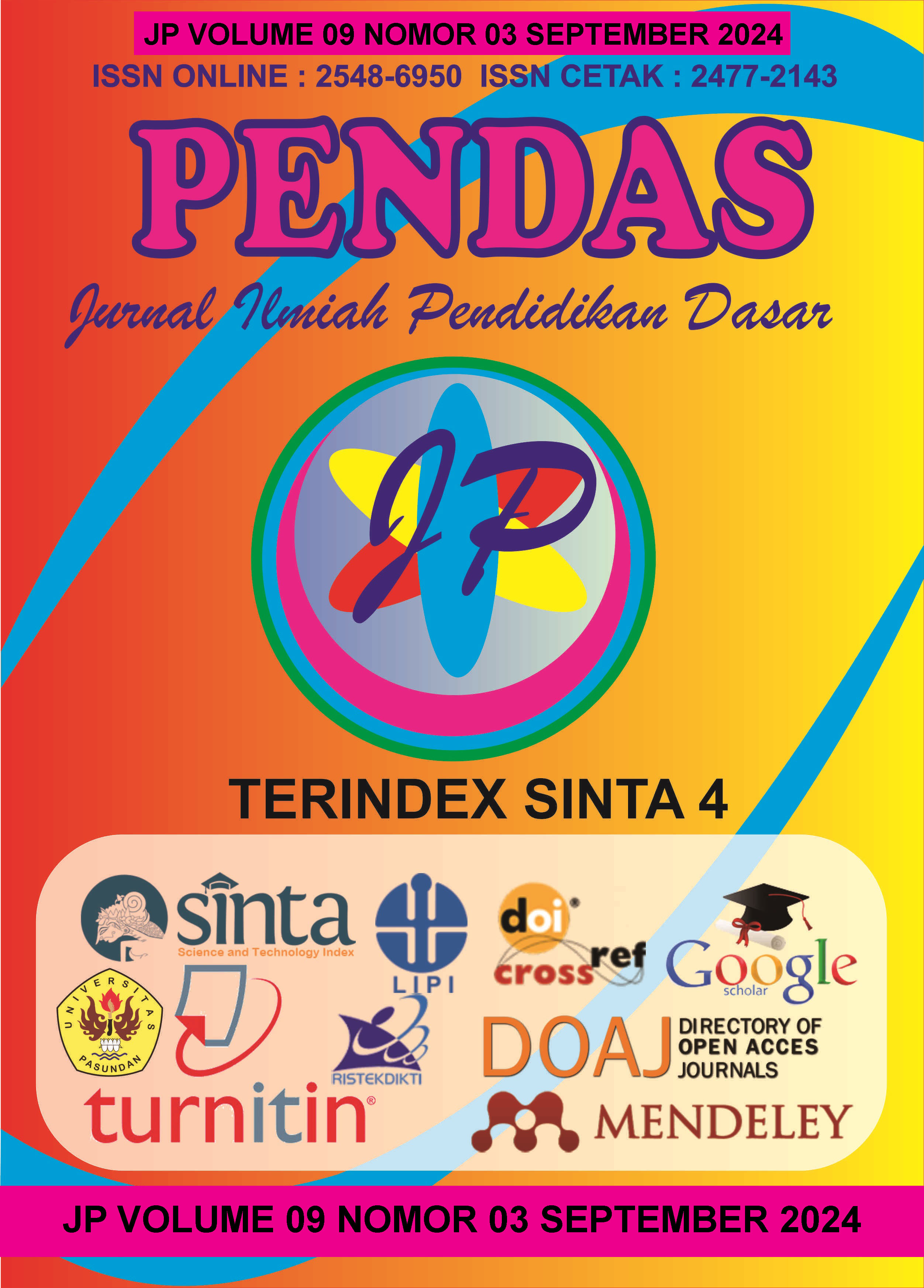PERBANDINGAN METODE CIRC (COOPERATIVE, INTEGRATED, READING, AND COMPOSITION) DAN METODE SQ3R (SURVEY, QUESTION, READ, RECITE, AND REVIEW) TERHADAP KEMAMPUAN MEMBACA PEMAHAMAN DAN HASIL BELAJAR SISWA KELAS V SEKOLAH DASAR
DOI:
https://doi.org/10.23969/jp.v9i3.16996Keywords:
CIRC method, learning outcomes, reading comprehension ability, SQ3R methodAbstract
This research discussesd the Comparison CIRC (Cooperative, Integrated, Reading, And Composition) Method and SQ3R Method (Survey, Question, Read, Recite, And Review) on Reading Comprehension Ability and Learning Outcomes of Class V Students of Cluster 1 Elementary School, Tarowang District, Jeneponto Regency. This research aimed to determine whether there any differences in students’ reading abilities and learning outcomes using the CIRC learning method and the SQ3R learning method. The type of research used was quasy experimental design research with the Nonequivalent Multiple-Group Design type. The population in this study were all class V Cluster 1 Tarowang District which consists of three schools with a total 128 students. The research sample chosen was class V students UPT SD Negeri 4 Tarowang, totaling 40 students usingbo random cluster sampling technique. Data collection techniques in the research were carried out through test techniques to determine students’ reading comprehension abilities and learning outcomes in the form of multiple choice questions and descriptions of 20 questions, as well as observation sheets to find out the implementation of the CIRC method and the SQ3R method. The results of research based on descriptive analysis showed that the average value of the CIRC learning method was 84.50. Meanwhile, when applying the SQ3R learning method, an average score of 83 was obtained. This means that the CIRC learning method is more improved than the SQ3R learning method. Meanwhile, the results of the inferential analysis show that the CIRC learning method is more significant effect compared to the SQ3R learning method on the reading comprehension ability and learning outcomes of class V UPT SD Negeri 4 Tarowang students. This is based on the results of the paired sample t test obtained, namely the sig value. 0,001 < 0,005.
Downloads
References
Abidin, Z. (2017). Meningkatkan Keterampilan Membaca Meningkatkan Keterampilan Membaca Siswa Kelas XI Kecamatan Bontonompo , Kabupaten Gowa. Jurnal Nalar Pendidikan Volume, 5(1), 55–63.
Ali, M. (2020). Pembelajaran Bahasa Indonesia Dan Sastra (Basastra) Di Sekolah Dasar. PERNIK : Jurnal Pendidikan Anak Usia Dini, 3(1), 35–44. https://doi.org/10.31851/pernik.v3i2.4839.
Aprilentina, Fahrurrozi, Anwar, M., & Wicaksono, J. W. (2020). Penggunaan Metode Circ Pada Kemampuan Membaca Pemahaman Siswa. Buana Pendidikan: Jurnal Fakultas Keguruan Dan Ilmu Pendidikan, 16(30), 173–182. https://doi.org/10.36456/bp.vol16.no30.a2715
Bambang, S. (2023). Pengaruh Metode CIRC Terhadap Kemampuan Membaca Pemahaman Berbasis Pendidikan Karakter Siswa Kelas V Sekolah Dasar. Journal of Contemporary Issue in Elementary Education, 1(1), 50–61. https://doi.org/10.33830/jciee.v1i1.5115
Justika, Munirah, M., & Rosdiana, R. (2022). Kemampuan Menganalisis Struktur Bahasa pada Teks Deskripsi Kelas ViIISMPN 10 Barru. DEIKTIS: Jurnal Pendidikan Bahasa Dan Sastra, 2(2), 129–136. https://doi.org/10.53769/deiktis.v2i2.252.
Karim, M. F., & Fathoni, A. (2022). Pembelajaran CIRC dalam Menumbuhkan Keterampilan Membaca Siswa Sekolah Dasar. Jurnal Basicedu, 6(4), 5910–5917. https://doi.org/10.31004/basicedu.v6i4.3164
Kirana Dewi, D., Setiawan, H., & Makki, M. (2021). Pengaruh Metode SQ3R Terhadap Kemampuan Membaca Pemahaman Peserta Didik Kelas IV SDN 2 Rumak Tahun Pelajaran 2020/2021. Jurnal Ilmiah Widya Pustaka Pendidikan, 9(1), 44–51.
Know, W. S., & Do, C. A. N. (2019). PISA 2018 Results (Volume I): Vol. I. https://doi.org/10.1787/5f07c754-en.
Krismanto, W., Halik, A., & Sayidiman, S. (2015). Meningkatkan Kemampuan Membaca Pemahaman Melalui Metode Survey, Question, Read, Recite, Review (Sq3R) Pada Siswa Kelas Iv Sd Negeri 46 Parepare. Publikasi Pendidikan, 5(3). https://doi.org/10.26858/publikan.v5i3.1616
Rahmi, Y., & Marnola, I. (2020). Peningkatan Kemampuan Membaca Pemahaman Siswa Melalui Model Pembelajaran Cooperative Integrated Reading and Compotion (Circ). Jurnal Basicedu, 4(3), 662–672. https://doi.org/10.31004/basicedu.v4i3.406
Safitri, D. A., & Ngaisah, S. (2018). Pengaruh Metode CIRC (Cooperative Integrated Reading and Composition) Terhadap Kemampuan Membaca Pemahaman Siswa Pada Materi Cerita Rakyat. Primary: Jurnal Keilmuan Dan Kependidikan Dasar, 10(1), 75–84.
Sarika, R. (2021). Analisis Kemampuan Membaca Pemahaman Siswa Kelas V Di Sd Negeri 1 Sukagalih. CaXra: Jurnal Pendidikan Sekolah Dasar, 1(2), 49–56. https://doi.org/10.31980/caxra.v1i2.1437
Satriani, Munawir, A., Khair, U., & Putriani, N. (2022). The Impact of Using A Reciprocal Teaching Strategy on Reading Comprehension By Prospective Teachers. ETDC: Indonesian Journal of Research and Educational Review, 1(2), 169–175. https://doi.org/10.51574/ijrer.v1i2.334.
Sugiyono. (2016). Metode Penelitian Kuantitatif, Kualitatif, dan R&D. CV Alfabeta.
Tahmidaten, L., & Krismanto, W. (2020). Permasalahan Budaya Membaca di Indonesia (Studi Pustaka Tentang Problematika & Solusinya). Scholaria: Jurnal Pendidikan Dan Kebudayaan, 10(1), 22–33. https://doi.org/10.24246/j.js.2020.v10.i1.p22-33
Downloads
Published
Issue
Section
License
Copyright (c) 2024 Pendas : Jurnal Ilmiah Pendidikan Dasar

This work is licensed under a Creative Commons Attribution 4.0 International License.



















